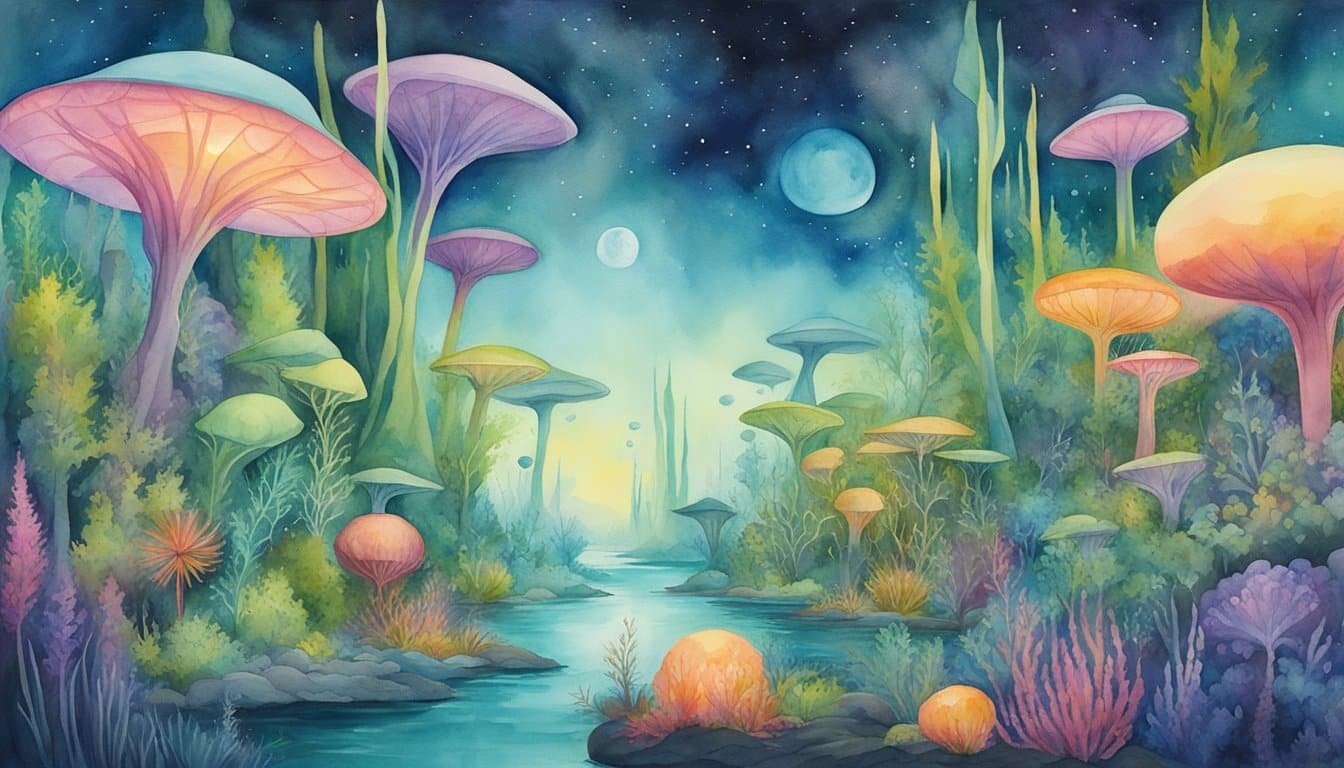Theoretical Appearances of Aliens
When venturing into theories about alien appearances, scientists consider a vast range of physical forms, taking cues from the diversity of life on Earth and the possibilities of different evolutionary paths and chemical compositions beyond our planet.
Morphological Diversity
Morphological diversity on Earth—from the tentacled octopus to the majestic lion—suggests that extraterrestrial life forms could display an equally staggering variety of physical structures. The theories on alien anatomy contemplate beings with multiple arms or legs, possibly adapted to their environments in ways humans might find hard to imagine. For instance, low gravity worlds may favor beings with elongated limbs, while extraterrestrials from high gravity planets might evolve with stockier builds. Moreover, the presence of features such as prehensile tails or exoskeletons for protection could be common, especially if these traits offer evolutionary advantages on their respective worlds.
Biochemical Possibilities
Delving into the potential chemistry of alien life, researchers hypothesize beyond the carbon-based blueprint of life on Earth. Some theories propose that extraterrestrials might be silicon-based, leveraging the element’s abundant presence in the universe. Alternatively, creatures akin to sentient clouds of gas with no fixed form could exist in atmospheres vastly different from our own. Other speculations entertain the idea of iron-based life forms or beings that employ an entirely different chemical composition, unseen on our planet. The very fabric of extraterrestrial physiology could challenge the Earth-centric view that life is symmetrical, leading to potentially unconventional and asymmetric forms.
If aliens have evolved with different sensory needs, their ears and eyes may be adapted in unexpected ways, or they may even utilize senses that humans lack. Theories also point to the prospect of adaptations like bilateral symmetry, a common trait among Earth’s animals, which could be advantageous for movement and coordination, or entirely alien biotypes with structures unimaginable to humans.
Sensory and Communication Systems
Exploring the mysteries of alien physiology, we often draw parallels with Earth’s own diverse life forms to conceptualize how extraterrestrials might sense and interact with their environment.

Adaptation to Environments
Alien sensory systems are bound to be as diverse as the planets they hail from. Just like elephants use their acute hearing and dolphins navigate with echolocation, aliens might have evolved sound and smell sensors perfectly attuned to their ecological niche. Imagine beings on a dimly lit world with binocular vision like an owl, enabling them to see in the dark, or inhabitants of a gas giant who, much like octopuses, could have sophisticated touch receptors to ‘see’ through dense atmospheres.
Communication Methods
When it comes to inter-species dialogues on Earth, birds perform intricate songs, and elephants can communicate over long distances using infrasound. In similar fashion, extraterrestrial communication could range from complex pheromones—chemical signals seen in many earth insects—to rich acoustic systems. Perhaps these alien signals are as varied as the languages found on Earth, or even beyond human perception. Just as an elevated head is a universal sign among many animals on Earth for maintaining a lookout and protecting the vital brain, alien communication might involve an intricate display where body position plays a pivotal role.
Advanced Alien Technologies and Intelligence

Speculations about extraterrestrial life often bring to mind images of beings with technologies surpassing our own. Astounding feats of engineering, hinting at a profound intelligence and an understanding of the cosmos, are fundamental to these visions of advanced alien civilizations.
Technological Integration
Aliens with advanced technology might boast an intimate integration of machinery and biology, a concept that is not alien to humanity’s own aspirations. For example, on alien worlds, it is conceivable that technology could be biologically integrated to enhance survival, enabling a seamless interaction with their environment. The engineering of such systems could be so advanced that it would appear almost magical to us, drawing on principles of astrophysics that we are only beginning to understand. Imagine a society where Avi Loeb-like figures are the norm, their everyday tools the equivalent of our most cutting-edge astrophysical instruments.
Intelligence and Consciousness
When discussing extraterrestrial intelligence, one must ponder the brain capacity of such beings. Could they possess a consciousness far exceeding our own? The Milky Way galaxy alone might be teeming with diverse forms of intelligence, ranging from bacteria with DNA-like molecules to sentient robots capable of self-repair. The potential complexity of alien intelligence suggests that Earth-like planets may have given rise to creatures with cognitive abilities beyond what humans can currently comprehend, possibly manipulating their environments in ways we can’t yet envision.
Alien Habitats and Lifestyles

As we gaze into the night sky, the mysteries of alien lives tickle our curiosity. What would life look like beyond Earth, and how would creatures adapt to the myriad environments the universe could offer?
Extraterrestrial Ecology
The environments where aliens could potentially exist are as diverse as the Milky Way itself. Planets orbiting stars at a just-right distance could mimic Earth‘s temperate climes, supporting a photosynthesis-based ecology. Conversely, extremophiles might thrive in the crushing depths of interstellar space, where light is sparse and sources of energy are exotic, like hydrothermal vents that sustain life in Earth’s deep oceans. The frigid or scorching planets near the edges of habitability would push the temperature tolerances of life forms, coaxing out unique survival strategies. Life on other planets might harness ambient light or alternative energy forms, deeply influencing their biological structures and functions.
Locomotion and Physical Capabilities
Moving through varied environments demands an array of physical abilities. On worlds with thick atmospheres, life forms might evolve with flying capabilities, using broad wings to glide through dense air. The ambient density of the medium they move through, whether gas or liquid, would shape their form – sleek for high-speed swimming, perhaps, or broad for maximum buoyancy. In comparison, a planet’s gravity affects locomotion significantly; lower gravity might give rise to bipedal and upright stances, allowing creatures to cover ground effectively as they migrate or hunt. In environments with consistent light conditions, symmetry in biological structures provides balance and direction for mobile life forms, be they scuttling across a rocky exoplanet or navigating through the vast oceans beneath icy crusts.
Do Revolutionary Tech Trendsetters Offer Insights into What Aliens Look Like?
Do revolutionary tech trendsetters offer insights into what aliens look like? As they push boundaries in artificial intelligence and virtual reality, these innovators inspire imaginative visions of extraterrestrial life. Their creative concepts often intertwine, hinting that advancements in aliens and revolutionary technology could unlock secrets about potential alien civilizations.
Human Perspectives and Misconceptions

When envisioning aliens, humans often draw from a well of popular myths and movies, yet the reality posited by scientists tells a different story, one less influenced by earthly biases.
Cinematic Representation
Cinema has a profound impact on how we imagine extraterrestrial beings. Common Hollywood depictions feature creatures with bilateral symmetry, walking upright on two legs with a pair of hands that have fingers similar to humans. Notable examples include the venerable E.T. with his iconic elongated finger, and the menacing xenomorphs of the Alien franchise. These aliens often resemble a mash-up of various Earth creatures: mammals, birds, and even plants. Their familiar form makes them more relatable—or more terrifying—to moviegoers.
- How Movies Portray Aliens:
- Often humanoid
- Common traits: two eyes, a nose, a mouth
- Emotionally resonant with human audiences, either through empathy or fear
Scientific Theories vs. Pop Culture
In contrast to cinematic aliens, scientists speculate that extraterrestrial life could diverge significantly from earthly life forms. Astronomers and astrobiologists argue that the conditions on other planets could give rise to life that’s vastly different from what we see on Earth. The recent interstellar object ‘Oumuamua sparked discussions about whether we could recognize alien technology if we saw it. While pop culture clings to the image of bats and birds with hands, real extraterrestrial life might not resemble Earth’s mammals at all—or even possess what we recognize as hands or fingers. The building blocks of life on another planet could lead to an entirely new tree of life that doesn’t parallel Earth’s fauna.
- Assumptions Challenged by Science:
- Symmetry: On Earth, bilateral symmetry is common, but extraterrestrials might not exhibit this.
- Sensory Organs: Eyes and ears are crucial for Earth species, yet aliens may have evolved different senses.
- Locomotion: The bipedal movement is familiar, but extraterrestrial creatures might move in unfathomable ways.

